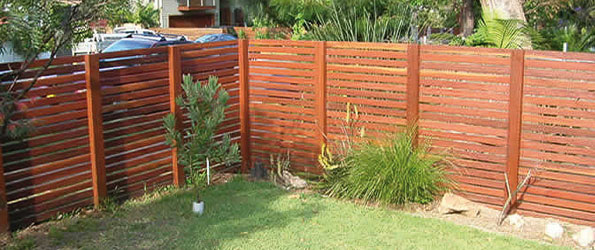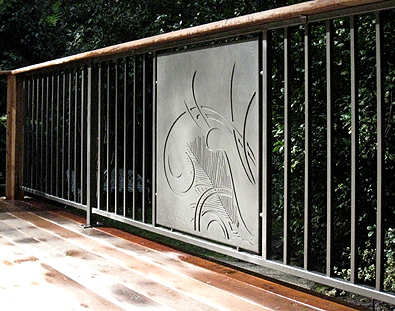Although there is a huge array of pool fencing options on the market, the task of picking the best option for your pool area does not need to be daunting. For starters the fence should have a similar style to your home and yard. For example, if you prefer modern, minimal and clean lines, then a glass fence will look fabulous. If your home is a bit more cottage-like, or you have a luscious garden, then gabion or brush fencing will look fantastic. Regardless of the look you choose, there is always a pool fencing solution within your budget, wherever you live in Australia.
Here are 5 tips on how to choose the best fencing for you.
1. Know what is available
The following list will help you become familiar with the fencing options out there. The better informed you are about options, the better choice you can make.
Tubular fencing


Tubular fencing provides that classic look that is sure to compliment any home and landscaping style. It is also possible to have tubular fencing customized to any idea you may have in mind such as incorporating automatic gates. Tubular fencing is constructed from vertical metal balusters - commonly aluminium, but stainless steel is also an attractive option - and is secured by a horizontal metal tube. This can be crowned by a balustrade, or left topless for a simple look.
Tubular fencing is a great option for homes with children and animals because it is very rugged and generally does not require any maintenance. This type of fencing is strong and secure, with an endless array of appearances, and will appeal to homeowners who are looking for a simple solution to pool fencing. Planting hedging shrubs along the line of a tubular fence will, over time, render the fence invisible, especially if it's black or dark green in colour.
Stainless steel wire rope fencing
Stainless steel upright fencing with horizontal stainless steel wires will not comply with pool fencing requirements. In fact anything with horizontal members that are further than 10mm apart will not comply with Australian Standards (2010).
Glass fencing

What better way to enjoy the hard work you put into your landscaping, then from the pool? Glass fencing is a sophisticated and modern option for pool fencing that compliments a yard with great landscaping, and an even better view, while still adhering to pool fencing requirements and keeping your pool safe and private. Glass fencing can incorporate intricate ballustrading for a dramatic effect, or can be left frameless for a stream-lined look. If there's an area of your fencing that is a little more in the open and exposed to prying eyes, then a custom-made privacy screen can be incorporated into the fencing. Glass fencing looks sophisticated and polished, but it is also very easy to care for and clean.

Brush fencing
Brush fencing adds a laid back, natural vibe surrounding your pool. Constructed from natural brush timber, this unique fencing option is perfect for yards with irregular shapes, or for homeowners who prefer to enhance their yard's natural beauty. It is ideal for those who want a private space. In addition brush fencing blends in beautifully with lush garden surroundings, transforming your yard into a tropical escape. You can make this product ,and similar products, comply with Australian Standards as long as you ensure the fence is tightly packed to prevent climbing and is 1200mm high with no more than 100mm.
Gabion fencing

For sloped yards, or for those who want to create a more old-fashioned effect surrounding a pool, gabion can be considered a good option. Although this is a relatively easy structure to build and can be inexpensive, it is also sturdy, simple to maintain and can look very attractive incorporated into a garden. For in-ground pools with a more natural look, this would be a great choice. By using locally available rocks and materials, the look of gabion fencing will blend in seamlessly into your yard's environment. If you choose this fencing option you and your installer will need to know the Australian Standard for pool fencing backwards, it's tricky, but possible, to make this fencing type comply with standards.
Timber fencing
Timber is a good choice if the fence placement and style may not be permanent. Although strong and durable with a classic cottage look, a wood fence is as easy to dismantle as it is to apply a new coat of paint. This type of fence, if designed and built correctly, easily complies with current Australian Standards.


Brick fencing
Brick fencing is a very strong and reliable fencing solution that will last a lifetime. This option is best suited for larger areas; large in-ground pools with a surrounding patio and garden area, for example. Brick fencing can also be incorporated into other fencing types, such as tubular, to create a personalized fencing solution. If you choose this fencing option ensure that the mortar joins are no more than 10mm to prevent climbing. This will also ensure that your fence complies with Australian Standards.
Colorbond fencing
Colorbond is a type of steel often used as siding on homes or roofs and is available in many colours. If colour choice is a big deciding factor when it comes to fencing options, then Colorbond is a durable and cost effective. If you are surrounding a large pool area with this material you can plant it out and within a few years the fence with be hidden.
2. Choosing the right colour
The last thing you want is to have a fence that stands out like a sore thumb. Your fence should compliment your home and yard, and be an accent, not the main focus. The in-fills of your fence should match the accents on your home, so keep in mind the colour of your windows and doors. An important option to consider if you don't want your fence to block your view is to choose glass balustrading, or in the case of tubular fencing, choose a dark colour that will essentially disappear into the background and that can accommodate planting. Many pool fencing companies suggest a colour that matches your window and gutter colours but if you have light coloured windows like Primrose, this is not a good option. Light coloured fences stand out, not blend into the landscape.
3. How much maintenance will your new fence require?
The amount of time you put into the upkeep of your new fence is entirely up to the type of fencing you choose. Brick, tubular and Colorbond will require nothing more than general repair of wear and tear over the year (and even then, very minimally), however glass and stainless steel fencing will need to be washed regularly to maintain that clean and polished look . Timber fences will require painting, staining and occasional replacing of boards, and gabion and brush will also need upkeep to maintain a solid structure over the years.
4. Be sure your fence complies with Australian safety standards!

Australia has specific guidelines that need to be followed, whether you are building a fence for the perimeter of your pool or yard. If you are building your fence yourself, make sure to follow the guidelines of the AS 1926.1-2007, particularly when you using non-standard materials. Otherwise, the company from which you buy the materials will be able to help you make sure the fence is compliant.
5. Choice based on cost.
It is important to keep in mind certain factors that will impact the cost of fencing. The major factors are whether you choose to do the fencing yourself and the materials you will be using. For example, gabion can be an economical method of fencing if you do the labour yourself and use local material that is abundant and inexpensive. However, when done by professionals, the labour and material costs can be very high. Usually tubular and timber fencing is the least expensive. Also try looking for innovative new materials, such as bamboo, which can be very economical and look great.
